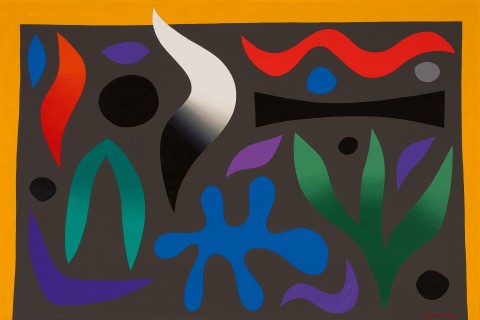FRUITS OF SUMMER, 1973
JOHN COBURN
synthetic polymer paint on linen
130.0 x 195.0 cm
signed lower right: Coburn
signed, dated and inscribed with title verso: FRUITS OF SUMMER / JOHN COBURN / SYDNEY 1973
Bonython Art Gallery, Sydney
The National Australia Bank Art Collection, acquired in 1975 (label attached verso)
John Coburn, Bonython Art Gallery, Sydney, 25 October - 10 November 1973, cat. 17
The Seventies: Australian Paintings and Tapestries from the Collection of National Australia Bank, National Gallery of Victoria, Melbourne, 15 October – 28 November 1982
Australian Pavilion at the World Expo '88, Australian Pavilion, Brisbane, 7 April - 4 November 1988
The Seventies Exhibition: Selected Paintings from the National Australia Bank Collection, MacLaurin Hall, The University of Sydney, Sydney, 6 September - 1 October 1989, cat. 7
The Seventies: Contemporary Australian Paintings from the National Australia Bank Collection, organised by Regional Galleries Association of New South Wales, New South Wales, cat. 7; and touring, Tamworth City Art Gallery, New South Wales, 24 May – 24 June 1990; Dubbo Regional Art Gallery, New South Wales, 11 July – 6 August 1990; Wagga Wagga City Art Gallery, New South Wales, 17 August – 10 September 1990; Moree Plains Regional Gallery, New South Wales, 3 October – 31 October 1990
Lindsay, R., The Seventies: Australian Paintings and Tapestries from the Collection of National Australia Bank, The National Bank of Australasia, Melbourne, 1982, pl. 24, p. 37 (illus.)
Amadio, N., John Coburn Paintings, Craftsman House, Sydney, 1988, p. 199
'First Public Display in Sydney of National's Paintings', The University of Sydney News, Sydney, vol. 21, no. 20, 1 August 1989, p. 170
‘John Coburn’s style is unique in Australian art and his contribution is one of inestimable worth. How does one value or rate in terms of dollars the art of a man whose vision elevates us to spiritual consciousness?’1
Unlike his contemporaries for whom abstraction represented the glorification of geometry and colour, John Coburn’s works are seldom purely cerebral or devoid of emotion. To the contrary, suffused with an overwhelming sense of celebration and allegory, his deeply personal iconography is predicated upon the promise of renewal – whether it be the regeneration of nature or the resurrection of the human spirit. Betraying strong affinities with the work of Matisse, Rothko, Picasso and Miró, his remarkable oeuvre encompassing paintings, prints and tapestries is thus which he reveals and exalts through the most direct of images. Indeed, highlighting the profound spiritual significance of his art, Nadine Amadio suggests Coburn as a pilgrim, ‘…his signs and symbols speak[ing] eloquently of a man who has been prepared to make a journey and return with the gifts of his insight.’2
When Coburn embarked upon the exquisite Fruits of Summer, 1973 offered here, he was universally regarded by public and private collectors alike as being at his creative height. The previous year, he had been appointed Head of Sydney's National Art School; his curtains of the 'Moon and Sun' had just endowed with added splendour the interiors of the Sydney Opera House; and the Australian Government had presented his 'Creation Series' of tapestries to the John F. Kennedy Centre for the Performing Arts, Washington. In 1973, his considerable international standing as a religious artist was augmented by the commissioning of the painting Tree of Life III, 1973, by the Vatican Museum's Gallery of Contemporary Religious Art, while closer to home, other works from this richly fertile year found their way into major state and corporate art collections, including Valencia, 1973 (Queensland Art Gallery / Museum of Modern Art, Brisbane); Aubusson Green, 1973 (National Gallery of Australia, Canberra) and Garden in Vevey, 1973 which was acquired by the BHP Collection.
Saturated with emotion and the promise of prosperity offered by the hottest of the four seasons, thus Fruits of Summer fuses balance and asymmetry to create a dynamic, harmonious composition in which the artist’s signature biomorphic forms float and colours pulsate with a vitalistic energy against the darker, sun-parched ground. Radiating passion and joy – whether through the hot hues of celebration and the earth, or the fecundity of lively greens, and resonant blues and purples – the work embodies Coburn at his finest, arresting in its simplicity and compelling in its ability to explore the profound and intuitive. As Coburn observed of his commitment to the allegorical and sensory potential of his art, ‘Appearances are distracting. What you feel about a thing is important, not what it looks like. I don't want to teach people to see. I want to get them to feel’.’3
1. Strzynecki, P., 'Beyond Psalm 46' in John Coburn, Australian Galleries, Melbourne, 2000, p.8
2. Amadio, N., John Coburn: The Paintings, Craftsman House, Sydney, 1988, p. 10
3. The artist, cited in Klepac, L., John Coburn: The Spirit of Colour, The Beagle Press, Sydney, 2003, p. 33
VERONICA ANGELATOS
